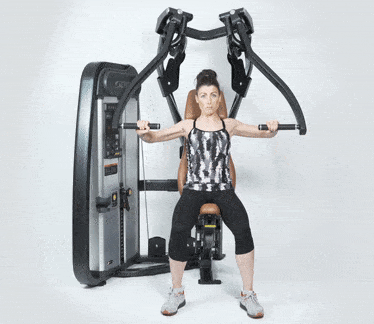What is a seated chest press?
The seated chest press is a resistance exercise machine used to develop the upper body. The main target area is the pectoral muscles in the chest with the triceps and deltoids also being activated as assisters.
The majority of gyms will have chest press machines of some description as they allow members to perform pressing movements if they are not confident enough to use free weights on a bench.
Experienced users will also use a chest press as it offers convenient weight selection and a constant 'tension; movement for accessory movements.
Which muscles are targeted with a seated chest press?

The main target muscle with the chest press is the pectoral muscle in the chest. As it is a pressing exercise, you will also be activating the anterior deltoid (front shoulder) and tricep muscles with the movement.
The chest press is a compound movement as it does put a lot of strain on the assister muscles and it is a good option if you are unable to perform a bench press or dumbbell press.
Performing a seated press in a neutral position sill target the entire pectoral muscle with more emphasis on the midsection. As with a bench press, you can alter your position to target either the upper or lower portion of the pectoral muscles.
Many gyms will have an incline seated press for targeting the upper chest. This would target the same portion of the chest that an incline bench press would.
Decline seated press machines are a little harder to come by. It is possible to use a standard seated press machine and raise the seat to a high level. If you do this, make sure that you are not putting strain on your shoulders by pressing in an awkward manner.
If you are not connecting fully with your pectoral muscles with this exercise, opt for a decline bench press or chest dips. These are both excellent ways to target the lower portion of the pectoral muscles.
How do I perform a seated chest press?
The seated chest press is a relatively simple exercise to perform. It can be used with a low weight selection with the focus being on form, squeezing the muscle and a slow negative movement.
Alternatively, the weight can be piled on for heavy sets of 3-5 reps. Your choice will depend on whether you are trying to achieve hypertrophy or strength gains.
- Select your seat height (for a neutral press, keep the handles at shoulder height).
- Place a pin in the weight stack for your desired resistance and sit on the machine.
- Place your palms on the handles just wider than shoulder-width and take a deep breath.
- Upon exhale, press the weight away from your body. Try not to straighten the arm fully in order to maximise time under tension.
- Hold the position for two seconds and squeeze the chest muscles.
- Slowly bring the handles back towards your chest in a controlled movement.
- Repeat for the required number of reps and sets.
The general recommendation is that you should perform sets of 8-12 reps for hypertrophy and sets of 3-6 reps for strength gains. Whichever ones you choose, make sure you are taking each set to failure. Training to failure is essential to maximise strength and muscle gains.
The seated press is great for this as it allows you to push every set without the need for a spotter.
Variations of the seated press.
Incline seated press.

The incline seated press is performed on an incline chest press or hammer press machine. It is similar to an incline bench press in that it targets the upper portion of the pectoral muscle.
The midsection, anterior deltoids and triceps are secondary muscles in this movement as with all pressing exercises.
It is possible to replicate the movement on some standard seated press machines by lowering the seat or leaning forward slightly whilst pressing. This is not ideal as it can cause issues with rotator cuffs or the brachialis muscle but may work for you.
The better alternative to an incline seated chest press is to opt for an incline bench press or incline dumbbell press. These both target the upper portion of the pectoral muscle in the same way.


